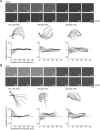Calaxin is required for asymmetric bend initiation and propagation in sperm flagella
- PMID: 37009483
- PMCID: PMC10061002
- DOI: 10.3389/fcell.2023.1136404
Calaxin is required for asymmetric bend initiation and propagation in sperm flagella
Abstract
Regulation of waveform asymmetry in flagella is critical for changes in direction when sperm are swimming, as seen during the chemotaxis of sperm towards eggs. Ca2+ is an important regulator of asymmetry in flagellar waveforms. A calcium sensor protein, calaxin, is associated with the outer arm dynein and plays a key role in the regulation of flagellar motility in a Ca2+-dependent manner. However, the underlying mechanism of regulating asymmetric waves by means of Ca2+ and calaxin remains unclear. To clarify the calaxin-dependent mechanism for generating Ca2+-dependent asymmetric flagellar waveforms, we analyzed the initial step of flagellar bend formation and propagation in the sperm of the ascidian Ciona intestinalis. Our experiment used demembranated sperm cells, which were then reactivated by UV flash photolysis of caged ATP under both high and low Ca2+ concentrations. Here, we show that initial bends in the flagella are formed at the base of the sperm and propagate towards the tip during waveform generation. However, the direction of the initial bend differed between asymmetric and symmetric waves. When a calaxin inhibitor (repaglinide) was applied, it resulted in the failure of asymmetric wave formation and propagation. This was because repaglinide had no effect on initial bend formation, but it significantly inhibited the generation of the subsequent bend in the reverse direction. Switching of dynein sliding activity by mechanical feedback is crucial for flagellar oscillation. Our results suggest that the Ca2+/calaxin mechanism plays an important role in the switching of dynein activity from microtubule sliding in the principal bend into the suppressed sliding in the reverse bend, thereby allowing the sperm to successfully change direction.
Keywords: caged ATP; calcium ion; cilia; dynein; sperm motility.
Copyright © 2023 Shiba, Baba, Fujiwara and Inaba.
Conflict of interest statement
Author EF is employed by Documentary Channel Co. Ltd. The remaining authors declare that the research was conducted in the absence of any commercial or financial relationships that could be construed as a potential conflict of interest.
Figures






Similar articles
-
A novel neuronal calcium sensor family protein, calaxin, is a potential Ca(2+)-dependent regulator for the outer arm dynein of metazoan cilia and flagella.Biol Cell. 2009 Feb;101(2):91-103. doi: 10.1042/BC20080032. Biol Cell. 2009. PMID: 18620543
-
Calaxin drives sperm chemotaxis by Ca²⁺-mediated direct modulation of a dynein motor.Proc Natl Acad Sci U S A. 2012 Dec 11;109(50):20497-502. doi: 10.1073/pnas.1217018109. Epub 2012 Nov 20. Proc Natl Acad Sci U S A. 2012. PMID: 23169663 Free PMC article.
-
Mechanical induction of oscillatory movement in demembranated, immotile flagella of sea urchin sperm at very low ATP concentrations.J Exp Biol. 2020 Oct 16;223(Pt 20):jeb225797. doi: 10.1242/jeb.225797. J Exp Biol. 2020. PMID: 32796042
-
Thinking about flagellar oscillation.Cell Motil Cytoskeleton. 2009 Aug;66(8):425-36. doi: 10.1002/cm.20313. Cell Motil Cytoskeleton. 2009. PMID: 18828155 Review.
-
Sperm flagella: comparative and phylogenetic perspectives of protein components.Mol Hum Reprod. 2011 Aug;17(8):524-38. doi: 10.1093/molehr/gar034. Epub 2011 May 17. Mol Hum Reprod. 2011. PMID: 21586547 Review.
Cited by
-
The Role of Soluble Adenylyl Cyclase in the Regulation of Flagellar Motility in Ascidian Sperm.Biomolecules. 2023 Oct 30;13(11):1594. doi: 10.3390/biom13111594. Biomolecules. 2023. PMID: 38002275 Free PMC article.
-
Calaxin is a key factor for calcium-dependent waveform control in zebrafish sperm.Life Sci Alliance. 2024 Jun 14;7(9):e202402632. doi: 10.26508/lsa.202402632. Print 2024 Sep. Life Sci Alliance. 2024. PMID: 38876797 Free PMC article.
References
-
- Baba S. A., Mogami Y. (1985). An approach to digital image analysis of bending shapes of eukaryotic flagella and cilia. Cell Motil. 5, 475. 10.1002/cm.970050605 - DOI
LinkOut - more resources
Full Text Sources
Research Materials
Miscellaneous

